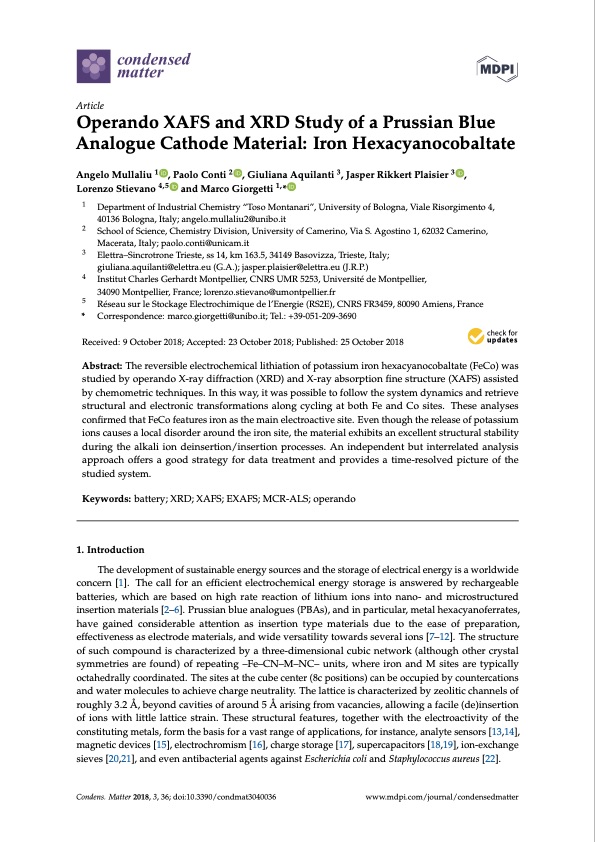
PDF Publication Title:
Text from PDF Page: 001
Article Operando XAFS and XRD Study of a Prussian Blue Analogue Cathode Material: Iron Hexacyanocobaltate Angelo Mullaliu 1 , Paolo Conti 2 , Giuliana Aquilanti 3, Jasper Rikkert Plaisier 3 , Lorenzo Stievano 4,5 and Marco Giorgetti 1,* 1 2 3 4 5 * Correspondence: marco.giorgetti@unibo.it; Tel.: +39-051-209-3690 Received: 9 October 2018; Accepted: 23 October 2018; Published: 25 October 2018 Department of Industrial Chemistry “Toso Montanari”, University of Bologna, Viale Risorgimento 4, 40136 Bologna, Italy; angelo.mullaliu2@unibo.it School of Science, Chemistry Division, University of Camerino, Via S. Agostino 1, 62032 Camerino, Macerata, Italy; paolo.conti@unicam.it Elettra–Sincrotrone Trieste, ss 14, km 163.5, 34149 Basovizza, Trieste, Italy; giuliana.aquilanti@elettra.eu (G.A.); jasper.plaisier@elettra.eu (J.R.P.) Institut Charles Gerhardt Montpellier, CNRS UMR 5253, Université de Montpellier, 34090 Montpellier, France; lorenzo.stievano@umontpellier.fr Réseau sur le Stockage Electrochimique de l’Energie (RS2E), CNRS FR3459, 80090 Amiens, France Abstract: The reversible electrochemical lithiation of potassium iron hexacyanocobaltate (FeCo) was studied by operando X-ray diffraction (XRD) and X-ray absorption fine structure (XAFS) assisted by chemometric techniques. In this way, it was possible to follow the system dynamics and retrieve structural and electronic transformations along cycling at both Fe and Co sites. These analyses confirmed that FeCo features iron as the main electroactive site. Even though the release of potassium ions causes a local disorder around the iron site, the material exhibits an excellent structural stability during the alkali ion deinsertion/insertion processes. An independent but interrelated analysis approach offers a good strategy for data treatment and provides a time-resolved picture of the studied system. Keywords: battery; XRD; XAFS; EXAFS; MCR-ALS; operando 1. Introduction The development of sustainable energy sources and the storage of electrical energy is a worldwide concern [1]. The call for an efficient electrochemical energy storage is answered by rechargeable batteries, which are based on high rate reaction of lithium ions into nano- and microstructured insertion materials [2–6]. Prussian blue analogues (PBAs), and in particular, metal hexacyanoferrates, have gained considerable attention as insertion type materials due to the ease of preparation, effectiveness as electrode materials, and wide versatility towards several ions [7–12]. The structure of such compound is characterized by a three-dimensional cubic network (although other crystal symmetries are found) of repeating –Fe–CN–M–NC– units, where iron and M sites are typically octahedrally coordinated. The sites at the cube center (8c positions) can be occupied by countercations and water molecules to achieve charge neutrality. The lattice is characterized by zeolitic channels of roughly 3.2 Å, beyond cavities of around 5 Å arising from vacancies, allowing a facile (de)insertion of ions with little lattice strain. These structural features, together with the electroactivity of the constituting metals, form the basis for a vast range of applications, for instance, analyte sensors [13,14], magnetic devices [15], electrochromism [16], charge storage [17], supercapacitors [18,19], ion-exchange sieves [20,21], and even antibacterial agents against Escherichia coli and Staphylococcus aureus [22]. Condens. Matter 2018, 3, 36; doi:10.3390/condmat3040036 www.mdpi.com/journal/condensedmatterPDF Image | XAFS and XRD Study of a Prussian Blue Analogue Cathode Iron Hexacyanocobaltate

PDF Search Title:
XAFS and XRD Study of a Prussian Blue Analogue Cathode Iron HexacyanocobaltateOriginal File Name Searched:
condensedmatter-03-00036.pdfDIY PDF Search: Google It | Yahoo | Bing
Sulfur Deposition on Carbon Nanofibers using Supercritical CO2 Sulfur Deposition on Carbon Nanofibers using Supercritical CO2. Gamma sulfur also known as mother of pearl sulfur and nacreous sulfur... More Info
CO2 Organic Rankine Cycle Experimenter Platform The supercritical CO2 phase change system is both a heat pump and organic rankine cycle which can be used for those purposes and as a supercritical extractor for advanced subcritical and supercritical extraction technology. Uses include producing nanoparticles, precious metal CO2 extraction, lithium battery recycling, and other applications... More Info
| CONTACT TEL: 608-238-6001 Email: greg@infinityturbine.com | RSS | AMP |